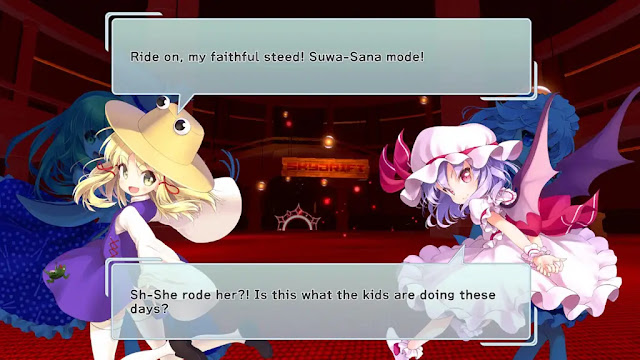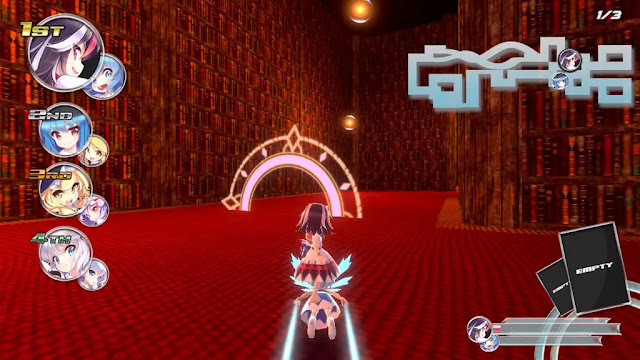Touhou Gensou Skydrift by developer illuCalab and publisher Phoenixx Inc.—Sony PlayStation 4 review written by Richard with a copy provided by the publisher.
Estimated reading time: 8 minutes
The Touhou series has many spinoff titles: RPGs, shooters, other bullet hell, rhythm, fighting, and now we have a racing title. You ever wondered what happens when you cross Mario Kart Double Dash with F-Zero and slap a Touhou skin on it? Well, you're about to find out with Touhou Gensou Skydrift.
Now right off the bat, instead of going straight into the plot used purely for obligatory purposes, let me mention that the campaign mode actually has a second campaign after you clear the first. Now that's out of the way, what actually is the plot? Well, Marisa (an ordinary magician) is setting up a racetrack in front of a shop, much to the owners chagrin. The shrine maiden Reimu comes by, and lets Marisa know that, for some reason, they are unable to fly because their magical/spiritual power has been weakened, (flying is a common thing in the world of Gensokyou). They see a dark figure dash off, and intending to chase after them, Reimu decides to combine her power with Marisa's, in order to fly. By jumping on her back and riding her like a surfboard through the air.
So, gameplay wise, we get into what really makes Touhou Gensou Skydrift take off. Those from Mario Kart backgrounds will notice a lot of similarities, as well as maybe some differences that could be frustrating at first. Like any good racing game, the goal is to maneuver your way through the course, placing first amongst the participants in order to continue. While there is a free run mode, chances are you will spend most of your time racing others, whether that be human players or computer controlled AIs. You have your “forward” button, a brake/drift, a switch, and a “spell” command, as well as a button you can hold to look behind you.
Now, in Mario Kart when you drift, you don't really lose speed, and you can build up a drift boost. In Skydrift, drifting is braking, and unless you are going through one of the numerous rings dotting the course, you will start to slow down. So why drift then? Well, this is the main reason I said Skydrift is part F-Zero: the stages can be brutally unforgiving. The last stage in the main campaign, I fell off the sides so many times I legitimately stopped counting after 20. While earlier stages are more Mario Kart-esque, later stages feel like some of the harder F-Zero courses, where there is more bottomless pit than racetrack, and you will be driving more on the walls and ceiling than the ground. And the best part? There are some seriously tight turns that are basically mandatory you either slow down or drift around.
Switching and spells, on the other hand, are a little more unique to Skydrift. As you fly through the course, you will notice red and gold magic circles. Flying through these not only boost your speed for a short period, but also charges up a portion of your magic gauge. This magic gauge is then used for both switching and using spells. Upon hitting the spell button the first time, you are randomly(ish) given a spell, similar to how Mario Kart works. You then hit the spell button again to use it. These range from attacks, to boosts, to defensive spells. Your magic gauge also has “tiers”, so you can charge multiple levels. Gaining a magic skill depletes the entire gauge, but generally the usefulness of the item is tied to how full your gauge is. As another handy note, both characters in the tag-team can have a spell at the ready, so if one character has a skill you want to keep, you can switch to the other to effectively “store” the spell.
Switching characters also uses a small part of the magic gauge, but will also provide a small speed boost while doing so. While switching, you are unable to steer though, so switching while going around a corner is rather ill advised. That being the case, apart from the boost and separately stored spells, each character has their own stats, as well as a unique spell. The unique spells can be identified by a picture of the characters face, and are generally really powerful in some way or another. For reference, you can see what each characters stats and special spells are when selecting the character in freeplay mode. Most special spells involve nailing first place with an attack, and/or providing a speed boost for a long time. On the other hand there are spells like Flandre's, which summons Laevateinn for a long time and will let you swing it at other racers every time you hit the spell button.
So how are the different courses? Well, the first couple are pretty basic Mario Kart style courses, but as you progress through the list, they get tougher and tougher. The last course in the first campaign was absolutely brutal, and some of the bonus courses not in the campaign mode are pretty brutal as well. The saving grace is that the computer controlled racers will have just as much trouble as you will. No seriously, the easiest way to beat the hardest computer player is choosing a tough course you've gotten used to, and watch the other racers fall of edges. That being said, the AI is rather good. Normally, upon winning a race, I would only be in first place by less than a second for a majority of the simpler courses, if I even won at all. I recall one course I only won by 80 milliseconds. I'd also like to note that, despite some initial misgivings for some of the tracks, I actually liked the vast majority of them, and there weren't any I hated. Yeah, the final course in the first campaign is super tough, but once you get used to it? One of my favourites.
Now what would a Touhou game be without its music? Skydrift is full of many interesting locations, and many remixed theme songs to go along with it. With a wonderful collaboration work with Akiyama Uni, SOUND HOLIC, and StarDrops, there's a lot of gorgeous soundtrack pieces, all fitted to meet that Mario Kart style racing vibe. Coupled with some well drawn stage backgrounds, and foregrounds, as well as cutely modelled 3D characters, Skydrift is definitely pleasing to both the ears and the eyes. Well, most of the time. Occasionally there are some stages that are a bit “crowded”, and it can be difficult to tell where you're going, especially if you throw in the multicoloured lights from the different spells characters can use, not even counting Marisa's Master Spark laser of “I can't see a bloody thing”. Thankfully, if you can't see anything, your opponents can'r really see anything either.
There is a good number of characters to choose from, with plenty of different stat combinations and unique spells, making each race a little unique in terms of both the characters you use (if you so choose) as well as who your opponents have selected. And yes, there can be duplicates in the opponents. In one race there were about 6 Orin, which I wasn't really expecting, but hey, it was certainly entertaining. The only real complaint I have is that there aren't a whole lot of courses. There are 16 total, or 4 “cups” in Mario Kart terms. While this is a little reminiscent of the older games, the newer titles have many more courses. Other than that though, the online is a little...spotty, I suppose you could say. I couldn't find a single person to play with after trying for about half an hour, but that could just be me being unlucky, or choosing a bad timeslot.
Summary
Overall, Touhou Gensou Skydrift is an absolutely great racing game. While combining the feel of both a Mario Kart title with closer to F-Zero style gameplay, challenging yet fun courses, and an amazing soundtrack, Skydrift will definitely meet your racing needs. No prior Touhou world knowledge is needed either, and with a large cast of characters to choose from, it's really fun to figure out what tag-team combo you like the best. Although the number of courses may be on the smaller side, they're all really fun, especially once you've had some time to practice on them. If you're looking for a tide-over between Mario Kart titles, or just want something a little different from them? Touhou Gensou Skydrift is definitely for you.
Score: 9 / 10

















0 comments:
Post a Comment